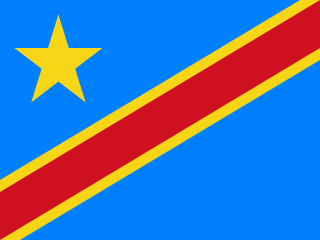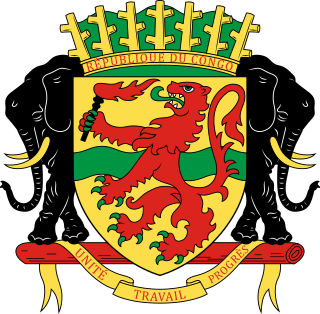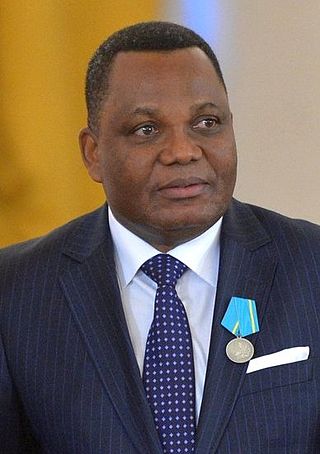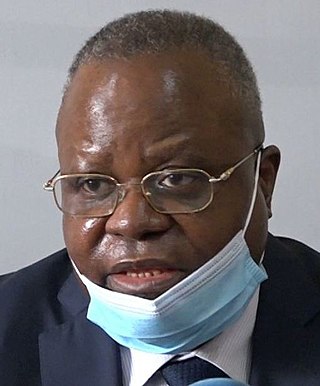
Niger–Congo is a hypothetical language family spoken over the majority of sub-Saharan Africa. It unites the Mande languages, the Atlantic–Congo languages, and possibly several smaller groups of languages that are difficult to classify. If valid, Niger–Congo would be the world's largest in terms of member languages, the third-largest in terms of speakers, and Africa's largest in terms of geographical area. Austronesian has almost as many member languages, although this is complicated by the ambiguity about what constitutes a distinct language; the number of named Niger–Congo languages listed by Ethnologue is 1,540.

The Democratic Republic of the Congo, also known as the DR Congo, the DRC, or Congo-Kinshasa, is a country in Central Africa. By land area the Congo is the second-largest country in Africa and the 11th-largest in the world. With a population of around 109 million, the Democratic Republic of the Congo is the most populous Francophone country in the world. The national capital and largest city is Kinshasa, which is also the economic center. The country is bordered by the Republic of the Congo, Central African Republic, South Sudan, Uganda, Rwanda, Burundi, Tanzania, Zambia, Angola, the Cabinda exclave of Angola, and the South Atlantic Ocean.

Plateaux is a department of the Republic of the Congo in the central part of the country. It borders the departments of Cuvette, Cuvette Ouest, Lékoumou and Pool, and internationally, the Democratic Republic of the Congo on the east and Gabon on the west. The regional capital is Djambala. Principal cities and towns include Gamboma and Lekana.
Gamboma is a town located in the Plateaux Department of the Republic of the Congo. It is served by Gamboma Airport.

The Catholic Church in the Republic of Congo is part of the worldwide Catholic Church, under the spiritual leadership of the Pope in Rome.

The Departments of the Republic of the Congo are divided into 86 districts and 6 communes; which are further subdivided into urban communities and rural communities ; which are further subdivided into quarters or neighborhoods (quartiers) and villages. Note the departments of Brazzaville and Pointe-Noire are made of 1 commune each, then divided in urban districts (arrondissements).

Parliamentary elections were held in the Republic of the Congo on 24 June 2007, with a second round initially planned for 22 July 2007, but then postponed to 5 August 2007. According to the National Commission of the Organization of the Elections (CONEL), 1,807 candidates stood in the first round for 137 seats in the National Assembly. The ruling Congolese Labour Party and parties and independent candidates allied with it won 125 seats, while two opposition parties won a combined 12 seats.
Bruno Jean-Richard Itoua is a Congolese politician who has served in the government of Congo-Brazzaville as Minister of Higher Education since 2016. Previously he was Director-General of the National Oil Company of Congo from 1998 to 2005, Minister of Energy and Hydraulics from 2005 to 2011, and Minister of Scientific Research from 2011 to 2016.
The Roman Catholic Archdiocese of Brazzaville is the Metropolitan See for the ecclesiastical province of Brazzaville in the Republic of the Congo.

Burnel Okana-Stazi is a Congolese football player for Thai League 3 club, PT Satun.

Congo, officially the Republic of the Congo or Congo Republic, also known as Congo-Brazzaville is a country located on the western coast of Central Africa to the west of the Congo River. It is bordered to the west by Gabon, to the northwest by Cameroon, to the northeast by the Central African Republic, to the southeast by the Democratic Republic of the Congo, to the south by the Angolan exclave of Cabinda, and to the southwest by the Atlantic Ocean.

Jean-Claude Gakosso is a Congolese politician who has served in the government of the Republic of the Congo as Minister of Foreign Affairs since 2015. Previously, he was Minister of Culture and the Arts from 2002 to 2015.
Alain Akouala Atipault is a Congolese politician who served in the government of Congo-Brazzaville as Minister of Communication from 2002 to 2009. Subsequently he was Minister of Special Economic Zones from 2009 to 2015 and again from 2016 to 2017.

Henri Ossébi is a Congolese sociologist and politician who served in the government of Congo-Brazzaville as Minister of Energy from 2011 to 2016. Previously he was Minister of Higher Education from 2002 to 2009 and Minister of Scientific Research from 2009 to 2011.

Mathias Dzon is a Congolese politician who served in the government of the Republic of the Congo as Minister of Finance from 1997 to 2002. Subsequently he was the National Director of the Bank of Central African States (BEAC) from 2003 to 2008 and a candidate in the July 2009 presidential election, although he decided to boycott the election shortly before it was held. He is the President of the Patriotic Union for National Renewal (UPRN).
Hugues Ngouélondélé is a Congolese politician who was Mayor of Brazzaville from 2003 to 2017. He also served as a Deputy in the National Assembly of Congo-Brazzaville beginning in 2002. He has served in the government as Minister of Sports since 2017.

The Republic of the Congo faces a number of ongoing health challenges.
Gamboma Airport is an airport serving the city of Gamboma in the Plateaux Department of Republic of the Congo. The runway is 5 kilometres (3.1 mi) north of town.
The Roman Catholic Diocese of Gamboma is a Catholic diocese located in the town of Gamboma in the ecclesiastical province of Brazzaville in the Republic of the Congo.












